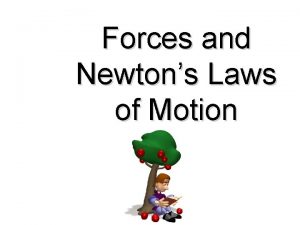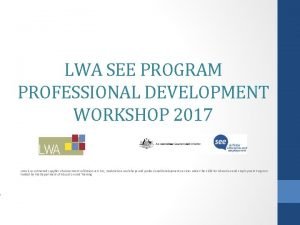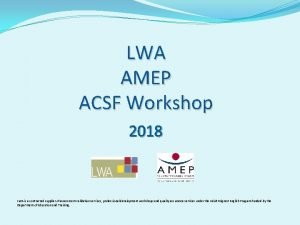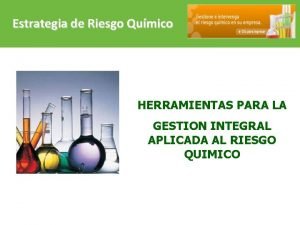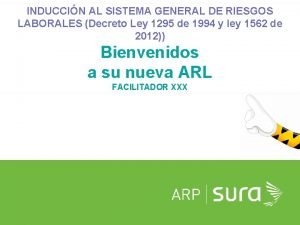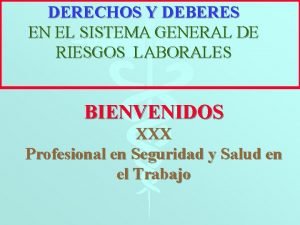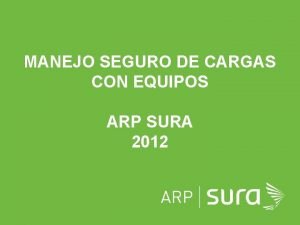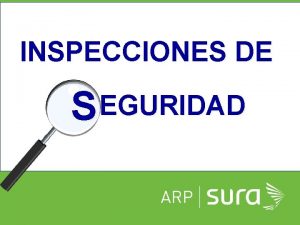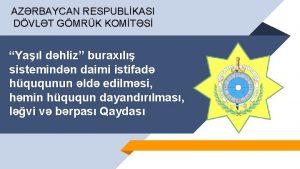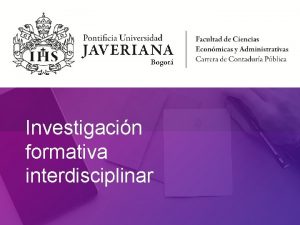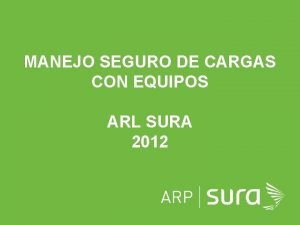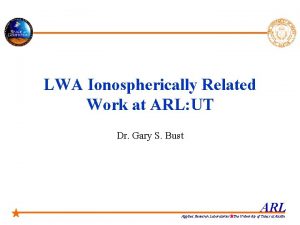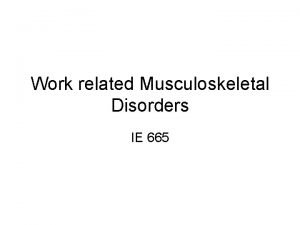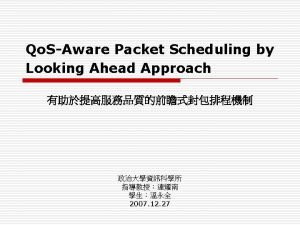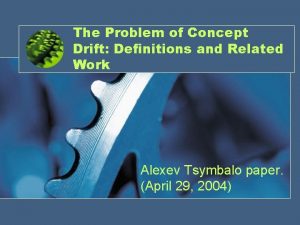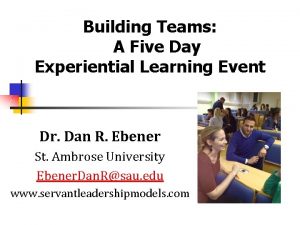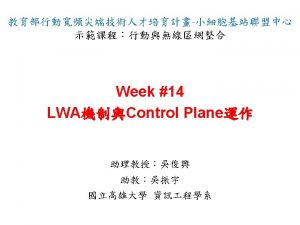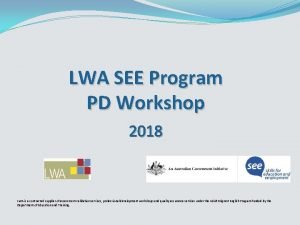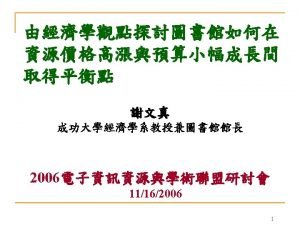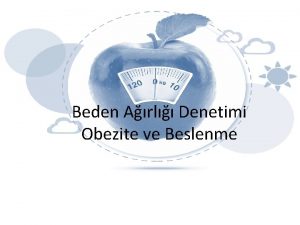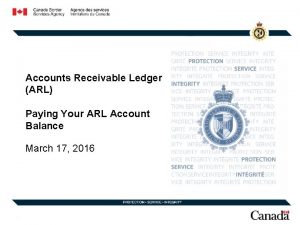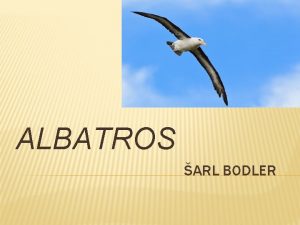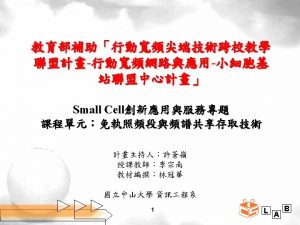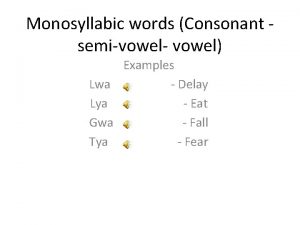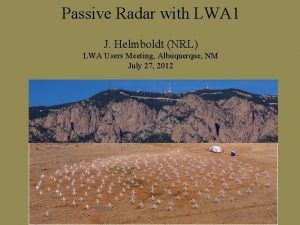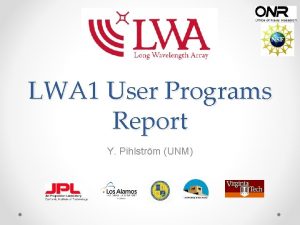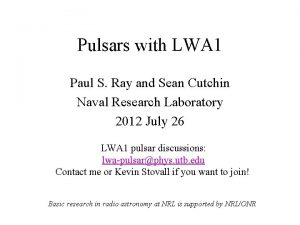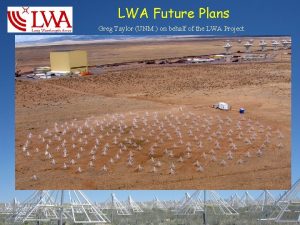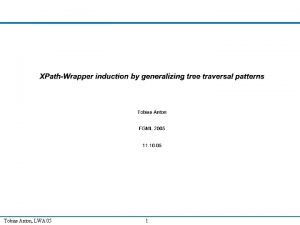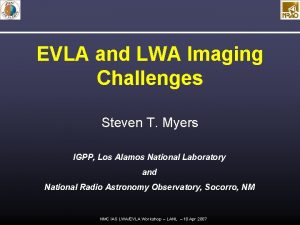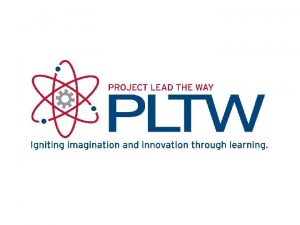LWA Ionospherically Related Work at ARL UT Dr
































- Slides: 32

LWA Ionospherically Related Work at ARL: UT Dr. Gary S. Bust Applied Research Laboratories ARL The University of Texas at Austin

Outline · · · Ionospheric Calibration of LWA History and Capabilities of IDA 3 D Results from IDA 3 D applied to LWA Future Directions at ARL: UT as they apply to LWA Applied Research Laboratories ARL The University of Texas at Austin

Ionospheric Calibration of LWA · ~ 50 stations spaced over a 300 - 400 kilometer region. · Each station consists of ~256 antennas over a 100 x 100 meter region. · The primary beam of a station is ~2 degrees x 2 degrees (~ 12 x 12 km at 300 km) · Know phase to ~ 1 degree everywhere in beam. Applied Research Laboratories ARL The University of Texas at Austin

Ionospheric Requirements · 1 degree phase requirement: Know TEC to ~ 10 -4 TECU (~ 100 times greater accuracy than GPS phase measurements) · At this sensitivity, need measurements every few seconds · Possibly need to specify TEC on scales of 1 km or less · Need to specify some kind of ionospheric map at each of 50 stations over a 300+ km baseline Applied Research Laboratories ARL The University of Texas at Austin

Measurement Equation · Simple version of visibility integral equation between two stations: · Actual equation includes effects of polarization, projection, leakage, electronic gain etc. And also integration in time and bandwidth. Applied Research Laboratories ARL The University of Texas at Austin

Issues Regarding Calibration · Astronomers need the ionospheric phase calibrated for each station, and everywhere within each station primary beam. · ~ 50 stations. · Say we need it every 1 km in a 10 x 10 km beam · Direct approach ~ 100 parameters per station ~ 5000 unknowns. · But, if we have 50 stations we have 50*49/2 ~ 1, 250 visibilities per calibrations source. Applied Research Laboratories ARL The University of Texas at Austin

Issues Regarding Measurement Equation · · · Non-linear forward integral model in the ionospheric phases Cannot necessarily bring ionospheric phases outside integral Cannot do synthesis via fourier transform of visibility Need ~ 100 sources in primary beam. Need to solve for visibilities for all 100 sources, between all stations - For 50 stations ~ 125, 000 visibilities Applied Research Laboratories ARL The University of Texas at Austin

Inversion Approaches · Use visibility data and measurement equation · Must solve for a non-linear integral equation to estimate ionospheric phases · ~ 100, 000 measurements, ~ 5000 unknowns. That is good!!! · Waves: If we require 2 D spatial from 1 -300 km we have ~ 1 e 5 unknowns -- not good!!! So, be more clever - wavelets? Different waves at each station? · Elevation / station · Pixels Applied Research Laboratories ARL The University of Texas at Austin

VLA Calibration Applied Research Laboratories ARL The University of Texas at Austin

Calibration Plan and Schedule · FY 07 - Develop forward simulation of visibilities including ionospheric simulations and simulated sky map - Develop initial inversion algorithm - Test algorithm on simulated data · FY 08 - Test algorithm on historical VLA data and data with Pie Town - Improved forward simulation - Refined inversion algorithm · FY 09 - Test algorithm on new VLA / Pie Town experiments with LWA stations added · Collaborate / Exchange results and ideas with LOFAR - Good working collaboration with Jan Noordam ASTRON Netherlands Applied Research Laboratories ARL The University of Texas at Austin

From MACE’ 93 to IDA 3 D: Ionospheric Imaging at ARL: UT · Ionospheric Imaging Algorithms at AR: UT - Simulations 1992 - Mart 2 D tomography 1992 -1994 - First 3 D/4 D algorithm (1995 -1998) · GPS + CIT + Ionosondes 3 D · First 3 D algorithms in the literature · Origins of IDA 3 D - True development of IDA 3 D as assimilation began in 1998 · 3 DVAR objective analysis · Development continuing at present · Experimental campaigns and instrumentations - 12 experimental campaigns since 1992 - Took over operations of Transit (now NIMS) for Navy (1996) - Developed CIDR – replacement for Magnavox 1502 (2000) Applied Research Laboratories ARL The University of Texas at Austin

ARL: UT Tomography Data Assimilation Experiments · · · Mace: ICMT 1: ICMT 2: Rad. White: Traits: Days 181 -349 Days 24 -46 Days 80 -110 Days 267 -355 Days 183 -365 Days 28 -35 PR Heater Days 21 -28 CIC 1 Days 173 -182 1998 Prairie. Dog Days 190 -278 CIC 2 Days 250 -273 1999 Alaska Day 285 - ? Greenland Day 278 - ? NECA Day 325 - ? 1993 9 receivers 1995 2 5 receiver arrays 1996 3 5 receiver arrays 1996 (ICMT 1 Config) 1997 (Caribbean) 1998 (8 receivers @ PR) (Caribbean) 1998 (West and East Cst) (Caribbean) 2000 - Current 2002 - Current Applied Research Laboratories ARL The University of Texas at Austin

Overview of IDA 3 D · Solves spatial 3 D tomographic inverse problem - maximum likelihood solution - Equivalent to 3 DVAR in meteorology - Solution also known as Kalman gain - Important inverse imaging math and development is in the choice of background model, model error covariance and data error covariance · Solution updated at user selected intervals (typically 5 -15 minutes) · Verified and validated many times · IDA 3 D has validated against altitude distribution of plasma density in addition to TEC validation Applied Research Laboratories ARL The University of Texas at Austin

Capabilities of IDA 3 D · Flexible - User can input customized irregular grid User can input any model empirical or physical Flexible error covariance data base inputs Entire program designed to be customized by user · Global - globally and regionally - Storms and quiet times · Data types - Accepts large number of different data types currently - Designed modularly to make easy to add new data sets. Applied Research Laboratories ARL The University of Texas at Austin

IDA 3 D Current Status of Development · Data Sources - Ground Based · GPS TEC · Tomography: Greenland, Alaska, NECA, Equatorial CIDR arrays · EISCAT, Sondrestrom, Millstone Hill ISR’s - Space Based · In-situ DMSP, CHAMP, ROCSAT · Occultations: Champ, SACC, GRACE, IOX · OSEC: Champ, SACC, GRACE · TOPEX TEC · Models - IRI, PIM, TIMEGCM, RIBG · Recent Improvements - Now solve for state vector log 10(Ne) - Assimilate ionosonde virtual heights versus frequency - Run in parallel on 24 processor cluster Applied Research Laboratories ARL The University of Texas at Austin

Validation of Tomography and IDA 3 D · Mid-America Computerized Ionospheric Tomography Experiment (MACE): 1993 - Comparisons with ionosonde virtual heights · Virtual height error ~ 6% · fo. F 2 error 1. 9 -3. 2 % - Single Sight Location (SSL) experiments · On 1650 km path, range error ~ 9% compared to 15% using classical SSL methods Applied Research Laboratories ARL The University of Texas at Austin

Ionosonde Virtual Height Comparisons MACE Papers: 1) “Application of ionospheric tomography to single-site location range estimation” Bust et al. , 1994, J. Imaging Sys. and Tech. 2) “Mid-America computerized ionospheric tomography experiment (MACE ‘ 93)”, Kronschnabl et al. , 1995, Radio Science Applied Research Laboratories ARL The University of Texas at Austin

Traits Campaign 1997 “Verification of ionospheric sensors”, C. Coker et al. , 2001, Radio Science. Applied Research Laboratories ARL The University of Texas at Austin

ISR Comparisons to IDA 3 D · Sondrestrom - Sept 30, 2000 - Oct 30, 2003 · EISCAT - Dec 12, 2001 Patches · Millstone Hill - Nov 20, 2003 uplifts Applied Research Laboratories ARL The University of Texas at Austin

IDA 3 D Sept. 30, 2000 compare to Sondestrom Watermann et al. , “Mapping plasma structures in the highlatitude ionosphere using beacon satellite, incoherent scatter radar and ground-based magnetometer observations”, Annals of Geophysics, 45, 2002 Applied Research Laboratories ARL The University of Texas at Austin

IDA 3 D Dec 12, 2001 compare to EISCAT Bust, G. S. and G. Crowley, “Tracking of polar cap ionospheric patches”, submitted to J. Geophys. Res. , 2006 Applied Research Laboratories ARL The University of Texas at Austin

IDA 3 D Oct. 30, 2003 compare to Sondestrom Applied Research Laboratories ARL The University of Texas at Austin

IDA 3 D Nov. 20, 2003 compare to Millstone Hill · IDA 3 D sees extreme uplift in plasma 17 -18 UT, as does Millstone Hill. Also notice the double E-F layers in IDA 3 D and Millstone Hill later. Applied Research Laboratories ARL The University of Texas at Austin

Statistical Validation of IDA 3 D with ISRs · 4 days in 2003. - Two closer to Equinox (2003, Oct 28, Oct 30) Two closer to Solstice (2003, Nov 19, Nov 20) Two magnetically quiet days (Oct 28, Nov 19) Two disturbed days (Oct 30, Nov 20) · Days need to have ISR coverage, and good data coverage · Results - Quiet Times · Standard deviations of 1. 0 E 11 and 1. 5 E 11 el/m 3 in the F-region · Mean offsets of -0. 3 E 11 and -0. 5 E 11 el/m 3 - Active Times · Standard deviations: 2. 2 E 11 and 3. 8 E 11 el/m 3 · Mean: 0. 08 E 11 and -0. 91 E 11 el/m 3 Applied Research Laboratories ARL The University of Texas at Austin

IDA 3 D Movies of Scientific Results · · Oct 30, 2003 polar VTEC movie November 20, 3003 slice along 290 longitude Oct 30, 2003 VTEC Movie over the USA Oct 30, 2003 slice movie over the USA Applied Research Laboratories ARL The University of Texas at Austin

Oct 30, 2003 Polar Movie Applied Research Laboratories ARL The University of Texas at Austin

Oct 30, 2003 VTEC over the USA with data coverage Applied Research Laboratories ARL The University of Texas at Austin

Oct 30, 2003 slice at 260 longitude. Log Density. Applied Research Laboratories ARL The University of Texas at Austin

IDA 3 D and LWA · Large scale imaging - 300+ km horizontal ~ 10 -25 km resolution - ~ 100 look directions (maybe more) every 10 seconds, 50 stations -> ~ 5000 data points. - Ingest into IDA 3 D and do high-resolution regional imaging every few seconds · Japan GPS network is similar in many ways - ~ 1000 receivers separated by ~ 10 km. - Currently see 6 -10 satellites ~ 6000 data points - Same amount of data, roughly same coverage area (somewhat larger) · IDA 3 D has already been successfully used to image results from Japan network. · This gives us great confidence in using it with LWA Applied Research Laboratories ARL The University of Texas at Austin

Japan 2003, Nov. 4 Altitude-latitude slice at 138 Long. over Japan. 1040 UT Nov. 4, 2003 Re-integrated VTEC from IDA 3 D over Japan. 1040 UT Nov. 4 2003 Applied Research Laboratories ARL The University of Texas at Austin

Future Directions: Mesoscale and LWA · Within a primary beam - ~ 1 km resolution over 12 -15 km regions - By crossing beams possibly look at 3 D + time variations in delta Ne · Ionospheric Regional Assimilative Model (IRAM) - 2 nd of two year development funded by ONR - Numerical data assimilation on regional scales - Expand continuity equation, electron, ion momentum, divergence of current in perturbations of background - Keep non-linear terms - Assume temperature perturbations are not drivers - Transform to Fourier wave-vector/frequency space - Iteratively solve non-linear terms - Transform back into real space-time Applied Research Laboratories ARL The University of Texas at Austin

Future Directions: Connecting LWA to Broader Community · GPS Workshop at ARL: UT (Sept. 30 -Oct. 1) · Introduce LWA to GPS TEC Community - closest to LWA, experience, ideas, algorithms · Third Meeting · Last one had one member of modeling / DA community - Tim Fuller Rowell Univ. of Colorado · This time invite other modelers / DA groups - Get them more involved in GPS TEC community - Share expertise of GPS group Applied Research Laboratories ARL The University of Texas at Austin
 Example of law of action and reaction
Example of law of action and reaction Lwa program
Lwa program Acsf mapping
Acsf mapping What are the two types of physical components
What are the two types of physical components Health vs skill related fitness
Health vs skill related fitness Cistema arl sura
Cistema arl sura El régimen sancionatorio del sgrl
El régimen sancionatorio del sgrl Higiene postural y manejo de cargas
Higiene postural y manejo de cargas Brigadas de emergencia sura
Brigadas de emergencia sura Deberes de la arl
Deberes de la arl Pausas activas arl sura
Pausas activas arl sura Aparejamiento de cargas
Aparejamiento de cargas Formato plan de accion
Formato plan de accion Riesgo mecanico en oficinas
Riesgo mecanico en oficinas Arl stats
Arl stats Arl vlz vlz
Arl vlz vlz Arl para aids
Arl para aids Caracteristicas de las pausas activas
Caracteristicas de las pausas activas Izaje de cargas sura
Izaje de cargas sura Arl ut
Arl ut Impairment related work expenses
Impairment related work expenses Work related musculoskeletal disorders definition
Work related musculoskeletal disorders definition Impairment related work expenses
Impairment related work expenses Introduction vs related work
Introduction vs related work The problem of concept drift: definitions and related work
The problem of concept drift: definitions and related work How are energy work and power related
How are energy work and power related Smart vs hard working
Smart vs hard working Basic components of social case work
Basic components of social case work I work all night i work all day
I work all night i work all day Present continuous con always
Present continuous con always Team vs working group
Team vs working group Smart work vs hard work group discussion
Smart work vs hard work group discussion Objectives of the work immersion portfolio
Objectives of the work immersion portfolio
